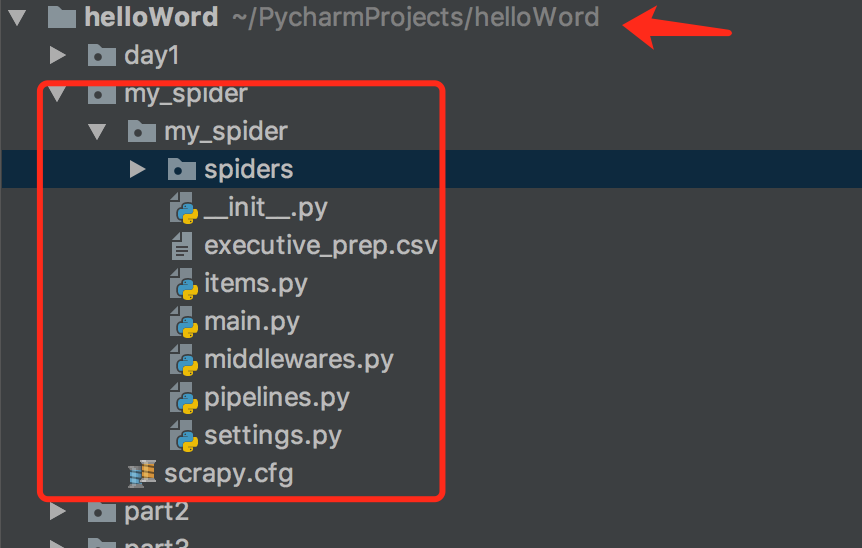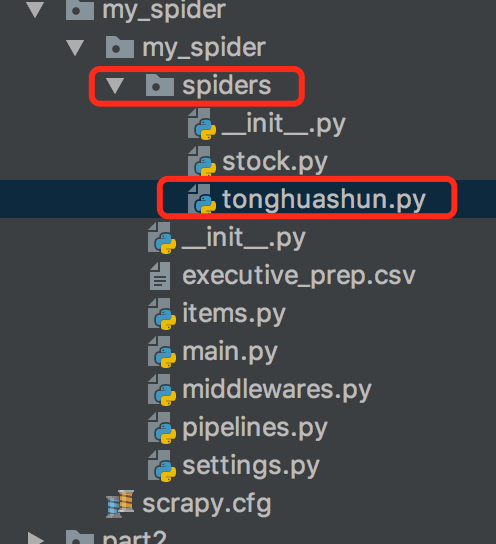scrapy简单说明
scrapy 为一个框架
框架和第三方库的区别:
库可以直接拿来就用,
框架是用来运行,自动帮助开发人员做很多的事,我们只需要填写逻辑就好
命令: 创建一个 项目 : cd 到需要创建工程的目录中, scrapy startproject stock_spider 其中 stock_spider 为一个项目名称 创建一个爬虫 cd ./stock_spider/spiders scrapy genspider tonghuashun "http://basic.10jqka.com.cn/600004/company.html" 其中 tonghuashun 为一个爬虫名称 "http://basic.10jqka.com.cn/600004/company.html" 为爬虫的地址
执行命令
1,创建一个工程:
cd 到需要创建工程的目录
scrapy startproject my_spide

2,创建一个简单的爬虫
cd ./stock_spider/spiders scrapy genspider tonghuashun "http://basic.10jqka.com.cn/600004/company.html" 其中 tonghuashun 为一个爬虫名称 "http://basic.10jqka.com.cn/600004/company.html" 为爬虫的地址

tonghuashun.py代码
import scrapy class TonghuashunSpider(scrapy.Spider): name = 'tonghuashun' allowed_domains = ['http://basic.10jqka.com.cn/600004/company.html'] start_urls = ['http://basic.10jqka.com.cn/600004/company.html'] def parse(self, response): # //*[@id="maintable"]/tbody/tr[1]/td[2]/a # res_selector = response.xpath("//*[@id="maintable"]/tbody/tr[1]/td[2]/a") # print(res_selector) # /Users/eddy/PycharmProjects/helloWord/stock_spider/stock_spider/spiders res_selector = response.xpath("//*[@id="ml_001"]/table/tbody/tr[1]/td[1]/a/text()") name = res_selector.extract() print(name) tc_names = response.xpath("//*[@class="tc name"]/a/text()").extract() for tc_name in tc_names: print(tc_name) positions = response.xpath("//*[@class="tl"]/text()").extract() for position in positions: print(position) pass
xpath :
''' xpath / 从根节点来进行选择元素 // 从匹配选择的当前节点来对文档中的节点进行选择 . 选择当前的节点 .. 选择当前节点的父节点 @ 选择属性 body/div 选取属于body的子元素中的所有div元素 //div 选取所有div标签的子元素,不管它们在html中的位置 @lang 选取名称为lang的所有属性 通配符 * 匹配任意元素节点 @* 匹配任何属性节点 //* 选取文档中的所有元素 //title[@*] 选取所有带有属性的title元素 | 在xpath中 | 是代表和的意思 //body/div | //body/li 选取body元素中的所有div元素和li元素 '''
scrapy shell 的使用过程:
''' scrapy shell 的使用过程 可以很直观的看到自己选择元素的打印 命令: scrapy shell http://basic.10jqka.com.cn/600004/company.html 查看指定元素命令: response.xpath("//*[@id="ml_001"]/table/tbody/tr[1]/td[1]/a/text()").extract() 查看 class="tc name" 的所有元素 response.xpath("//*[@class="tc name"]").extract() 查看 class="tc name" 的所有元素 下a标签的text response.xpath("//*[@class="tc name"]/a/text()").extract() ['邱嘉臣', '刘建强', '马心航', '张克俭', '关易波', '许汉忠', '毕井双', '饶品贵', '谢泽煌', '梁慧', '袁海文', '邱嘉臣', '戚耀明', '武宇', '黄浩', '王晓勇', '于洪才', '莫名贞', '谢冰心'] '''
scrapy框架在爬虫中的应用
在上个工程项目中cd 到 spidders 目录中,此处为存放爬虫类的包
栗子2: cd ./stock_spider/spiders scrapy genspider stock "pycs.greedyai.com"
stock.py
# -*- coding: utf-8 -*- import scrapy import re from urllib import parse from ..items import MySpiderItem2 class StockSpider(scrapy.Spider): name = 'stock' allowed_domains = ['pycs.greedyai.com'] start_urls = ['http://pycs.greedyai.com'] def parse(self, response): hrefs = response.xpath("//a/@href").extract() for href in hrefs: yield scrapy.Request(url= parse.urljoin(response.url, href), callback=self.parse_detail, dont_filter=True) def parse_detail(self,response): stock_item = MySpiderItem2() # 董事会成员信息 stock_item["names"] = self.get_tc(response) # 抓取性别信息 stock_item["sexes"] = self.get_sex(response) # 抓取年龄信息 stock_item["ages"] = self.get_age(response) # 股票代码 stock_item["codes"] = self.get_cod(response) # 职位信息 stock_item["leaders"] = self.get_leader(response,len(stock_item["names"])) yield stock_item # 处理信息 def get_tc(self, response): names = response.xpath("//*[@class="tc name"]/a/text()").extract() return names def get_sex(self, response): # //*[@id="ml_001"]/table/tbody/tr[1]/td[1]/div/table/thead/tr[2]/td[1] infos = response.xpath("//*[@class="intro"]/text()").extract() sex_list = [] for info in infos: try: sex = re.findall("[男|女]", info)[0] sex_list.append(sex) except(IndexError): continue return sex_list def get_age(self, response): infos = response.xpath("//*[@class="intro"]/text()").extract() age_list = [] for info in infos: try: age = re.findall("d+", info)[0] age_list.append(age) except(IndexError): continue return age_list def get_cod(self, response): codes = response.xpath("/html/body/div[3]/div[1]/div[2]/div[1]/h1/a/@title").extract() code_list = [] for info in codes: code = re.findall("d+", info)[0] code_list.append(code) return code_list def get_leader(self, response, length): tc_leaders = response.xpath("//*[@class="tl"]/text()").extract() tc_leaders = tc_leaders[0 : length] return tc_leaders
items.py:
import scrapy class MySpiderItem(scrapy.Item): # define the fields for your item here like: # name = scrapy.Field() pass class MySpiderItem2(scrapy.Item): names = scrapy.Field() sexes = scrapy.Field() ages = scrapy.Field() codes = scrapy.Field() leaders = scrapy.Field()
说明:
items.py中的MySpiderItem2 类中的字段用于存储在stock.py的StockSpider类中爬到的字段,交给pipelines.py中的MySpiderPipeline2处理,
需要到settings.py中设置
# -*- coding: utf-8 -*- # Scrapy settings for my_spider project # # For simplicity, this file contains only settings considered important or # commonly used. You can find more settings consulting the documentation: # # https://doc.scrapy.org/en/latest/topics/settings.html # https://doc.scrapy.org/en/latest/topics/downloader-middleware.html # https://doc.scrapy.org/en/latest/topics/spider-middleware.html BOT_NAME = 'my_spider' SPIDER_MODULES = ['my_spider.spiders'] NEWSPIDER_MODULE = 'my_spider.spiders' # Crawl responsibly by identifying yourself (and your website) on the user-agent #USER_AGENT = 'my_spider (+http://www.yourdomain.com)' # Obey robots.txt rules ROBOTSTXT_OBEY = True # Configure maximum concurrent requests performed by Scrapy (default: 16) #CONCURRENT_REQUESTS = 32 # Configure a delay for requests for the same website (default: 0) # See https://doc.scrapy.org/en/latest/topics/settings.html#download-delay # See also autothrottle settings and docs #DOWNLOAD_DELAY = 3 # The download delay setting will honor only one of: #CONCURRENT_REQUESTS_PER_DOMAIN = 16 #CONCURRENT_REQUESTS_PER_IP = 16 # Disable cookies (enabled by default) #COOKIES_ENABLED = False # Disable Telnet Console (enabled by default) #TELNETCONSOLE_ENABLED = False # Override the default request headers: #DEFAULT_REQUEST_HEADERS = { # 'Accept': 'text/html,application/xhtml+xml,application/xml;q=0.9,*/*;q=0.8', # 'Accept-Language': 'en', #} # Enable or disable spider middlewares # See https://doc.scrapy.org/en/latest/topics/spider-middleware.html #SPIDER_MIDDLEWARES = { # 'my_spider.middlewares.MySpiderSpiderMiddleware': 543, #} # Enable or disable downloader middlewares # See https://doc.scrapy.org/en/latest/topics/downloader-middleware.html #DOWNLOADER_MIDDLEWARES = { # 'my_spider.middlewares.MySpiderDownloaderMiddleware': 543, #} # Enable or disable extensions # See https://doc.scrapy.org/en/latest/topics/extensions.html #EXTENSIONS = { # 'scrapy.extensions.telnet.TelnetConsole': None, #} # Configure item pipelines # See https://doc.scrapy.org/en/latest/topics/item-pipeline.html ITEM_PIPELINES = { 'my_spider.pipelines.MySpiderPipeline': 300, 'my_spider.pipelines.MySpiderPipeline2': 1, } # Enable and configure the AutoThrottle extension (disabled by default) # See https://doc.scrapy.org/en/latest/topics/autothrottle.html #AUTOTHROTTLE_ENABLED = True # The initial download delay #AUTOTHROTTLE_START_DELAY = 5 # The maximum download delay to be set in case of high latencies #AUTOTHROTTLE_MAX_DELAY = 60 # The average number of requests Scrapy should be sending in parallel to # each remote server #AUTOTHROTTLE_TARGET_CONCURRENCY = 1.0 # Enable showing throttling stats for every response received: #AUTOTHROTTLE_DEBUG = False # Enable and configure HTTP caching (disabled by default) # See https://doc.scrapy.org/en/latest/topics/downloader-middleware.html#httpcache-middleware-settings #HTTPCACHE_ENABLED = True #HTTPCACHE_EXPIRATION_SECS = 0 #HTTPCACHE_DIR = 'httpcache' #HTTPCACHE_IGNORE_HTTP_CODES = [] #HTTPCACHE_STORAGE = 'scrapy.extensions.httpcache.FilesystemCacheStorage'
pipelines.py
# -*- coding: utf-8 -*- # Define your item pipelines here # # Don't forget to add your pipeline to the ITEM_PIPELINES setting # See: https://doc.scrapy.org/en/latest/topics/item-pipeline.html import os class MySpiderPipeline(object): def process_item(self, item, spider): return item class MySpiderPipeline2(object): ''' # 类被加载时需要创建一个文件 # 判断文件是否为空 为空写:高管姓名,性别,年龄,股票代码,职位 不为空:追加文件写数据 ''' def __init__(self): self.file = open("executive_prep.csv","a+") def process_item(self, item, spider): if os.path.getsize("executive_prep.csv"): # 写数据 self.write_content(item) else: self.file.write("高管姓名,性别,年龄,股票代码,职位 ") self.file.flush() return item def write_content(self,item): names = item["names"] sexes = item["sexes"] ages = item["ages"] codes = item["codes"] leaders = item["leaders"] # print(names + sexes + ages + codes + leaders) line = "" for i in range(len(names)): line = names[i] + "," + sexes[i] + "," + ages[i] + "," + codes[0] + "," + leaders[i] + " " self.file.write(line)
文件可以在同级目录中查看